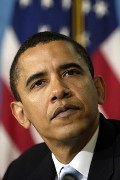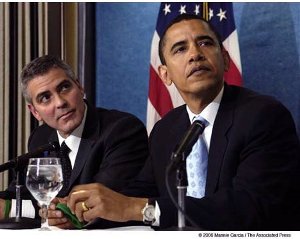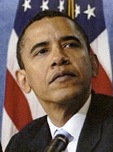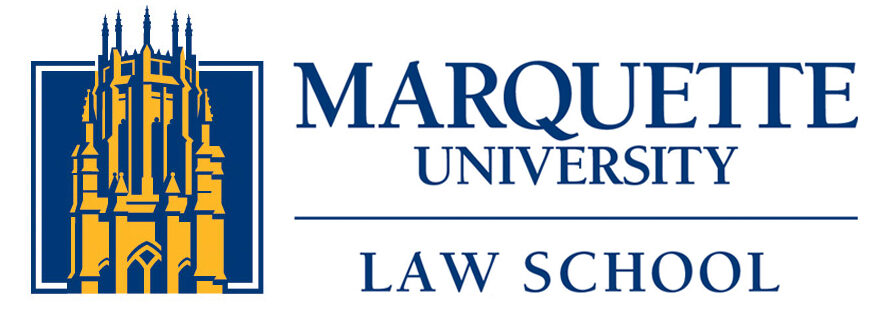
 (This is the fourth in a series of posts on Fairey v. Associated Press. See below for other posts in the series.)
(This is the fourth in a series of posts on Fairey v. Associated Press. See below for other posts in the series.)
There are two intriguing mysteries in the Shepard Fairey case related to how the Obama Hope poster (above right) was created. First, while Fairey’s poster looks pretty similar to Mannie Garcia’s photograph at left, Fairey actually claims he based his poster on a very different photograph, albeit one taken at the same event, with Obama looking in the same direction. Second, the complaint is fairly cagey about the actual creation process behind the poster. In particular, it’s not clear from the complaint whether Fairey simply photoshopped the Garcia photo, or rather created the poster by hand.
Why do either of these things matter? The first issue matters doctrinally; the amount of the copyrighted work that was taken helps to determine both infringement liability and counts in evaluating any fair use defense. The second issue matters more atmospherically; it just seems easier to credit a claim of substantial similarity, or conversely harder to credit a claim of fair use, if Fairey copied the original and altered it down, rather than creating a similar-looking version from the bottom up. I’d venture that that may be true even if the two processes led to exactly the same end product, although that might not make much sense as a theoretical matter.
So what’s the truth? Which image did Fairey use, and what did he do to it?
What’s the “original” photo?
Fairey admits that he based the poster’s image of Obama on a photograph taken by Mannie Garcia. In other words, he’s admitted “copying.” But that doesn’t end the story, because in order to be on the hook for infringement liability, Fairey must have taken a sufficient amount of the photo’s copyrightable elements. Specifically, if the AP were to sue Fairey (and if they can, I believe they will), they would need to show: (1) ownership of a valid registered copyright (the subject of previous posts); and (2)(a) actual copying of the work by the defendant (b) that rises to the level of substantial similarity. We’re assuming (1) is true, and Fairey admits (2)(a). The questions today all concern substantial similarity, and also fair use.
Here’s the image that, according to Fairey’s complaint, ¶¶ 18, 34, he based his poster on:

(An aside: I’m not sure where that copyright notice came from, but I think someone may have added it later. I got the jpeg file from Jim Danziger’s Year in Pictures blog. The image attached as Exhibit A to the Fairey complaint lacks the notice.)
If Fairey is correct that this is the image he used, that helps his case somewhat. He would have used a much smaller portion of this photo than the one above. But as bloggers Daryl Lang and Jim Danziger have noted,  Fairey’s claim seems highly implausible. Overlaying his “Hope” poster, slightly rotated, over the close-up Garcia photo (call it “Garcia A”) produces a perfect match—the eyes, the shoulders, even the lighting on Obama’s face all line up. However, overlaying the “Hope” poster on the wider shot above (call it “Garcia B”) produces significant discrepencies.
Fairey’s claim seems highly implausible. Overlaying his “Hope” poster, slightly rotated, over the close-up Garcia photo (call it “Garcia A”) produces a perfect match—the eyes, the shoulders, even the lighting on Obama’s face all line up. However, overlaying the “Hope” poster on the wider shot above (call it “Garcia B”) produces significant discrepencies.
Not only that, but it’s difficult to believe that Fairey, with his interest in propaganda art, would have used Garcia B. Obama’s chin in Garcia B is raised to an even higher position than in Garcia A, and his eyes are further off to the right; this has the effect of making him seem, not hopeful as in Garcia A, but aloof and distant—not at all the effect Fairey would have been  searching for. Perhaps Fairey has just had a memory lapse. But if not, and he’s engaged in a little retroactive wishful thinking, it’s not for very much benefit; I think the strongest arguments in his favor have nothing to do with the framing of the original photo. Furthermore, to the extent a judge or jury comes to the same conclusion, it just plain looks bad to have a misstatement like this in the complaint.
searching for. Perhaps Fairey has just had a memory lapse. But if not, and he’s engaged in a little retroactive wishful thinking, it’s not for very much benefit; I think the strongest arguments in his favor have nothing to do with the framing of the original photo. Furthermore, to the extent a judge or jury comes to the same conclusion, it just plain looks bad to have a misstatement like this in the complaint.
What does the complaint say about the poster creation process?
Another interesting question relates to how exactly Fairey created the Hope poster. That is, did he create the image by hand while sitting at his computer, looking at the Garcia photo as a model, or did he just photoshop a copy of the original? This might matter a little under copyright law; if Fairey made a digital copy of the photo and then edited it, that’s an additional reproduction he might be on the hook for, albeit one that no one apart from ever saw.
But the trend regarding so-called “intermediate copies”—digital copies used to produce something else, that are then discarded when the creation process is done—is that they are usually a fair use. So really it’s the end product that matters. And we have a copy of the end product that we can hold up next to the original; who cares by what method it was produced?
Fairey’s critics in the art world seem to care a lot; and so might jurors, and judges like the judges in Rogers v. Koons. When it comes to making a fair use argument, there is less intuitional pull in favor of a “mere copyist” who makes allegedly trivial alterations to a work of art using a computer program. Indeed, you can make your own Fairey-style Hope posters by uploading them to a website, which does the transformation automatically. There’s also a tutorial. If a paint-by-numbers company duplicated the Garcia photo, they might have a tough time too.
And, it seems, Fairey cares about the creation process, or at least his lawyers do. They are very coy about Fairey’s process in the complaint. I’m not sure why; I think it would be better to make the argument now, at the beginning of the case, why the transformation was artistic. Here’s what they say:
14. In conceiving and planning his work, Fairey came across a photograph of then Senator Obama taken at the National Press Club in April 2006 during an event at which he appeared with actor George Clooney to speak about the humanitarian crisis in the Darfur region of Africa.
(Emphasis mine.) “Came across”—that’s wonderfully passive. I.e., Shepard wasn’t searching for a photo to use, he just stumbled across one. By happenstance, really.
18. In creating the illustration of Obama used in Obama Progress and Obama Hope, Fairey used the Garcia Photograph as a visual reference.
As a “visual reference”? I’m not sure what that means. I’d be very, very surprised if the Garcia photo wasn’t edited in Photoshop. Why not just say it was “edited”? Sure, maybe that’s not as compelling, but it’s ceding ground to AP’s lawyers in later briefing to make snide remarks like, “Fairey made trivial changes to the AP Photo in a computer program—a process he calls using it as a ‘visual reference’ . . . ” Anyway, on with Paragraph 18:
Fairey transformed the literal depiction contained in the Garcia Photograph into a stunning, abstracted and idealized visual image that creates powerful new meaning and conveys a radically different message that has no analogue in the original photograph. While the evident purpose of the Garcia Photograph is to document the events that took place at the National Press Club that day in April 2006, the evident purpose of both Obama Progress and Obama Hope is to inspire, convince and convey the power of Obama’s ideals, as well as his potential as a leader, through graphic metaphor. By evoking stylized propaganda poster more often associated with autocrats and dictators, Fairey at once portrays the inevitability of Obama’s triumph, while suggesting qualities of wisdom and vision that pull viewers willingly into Obama’s message of hope, progress and change.
I love this paragraph. I bet Obama is sure glad that Fairey waited until the campaign was over to declare that his semi-official campaign poster draws its power from its similarity to propaganda for dictators. “Obama has qualities of wisdom and vision, just like those seen in this poster of Lenin!” The remainder of the paragraph tries to invoke as many copyright magic words as possible. Fairey “transformed” the photograph and created a “powerful new meaning” that “conveys a radically different message” from the original. But some of that language goes a bit too far, I think. To play up Fairey’s alterations as much as possible, the complaint plays down Garcia’s artistry, to the point where the very idea of copyright in news photographs would seem to be questionable. The original photo was merely a “literal depiction,” one that’s not very “stunning,” the purpose of which was merely to mechanically “document the event” rather than convey any message at all.
I may be a little sensitive here because I’ve been accused of attempting to “document” family vacations on film, whereas I view my photos as artistic, although admittedly numerous. But it is also true that, in my opinion, many news photographs attempt to go beyond “documenting” an event, as a security camera would, and instead try to inject some amount of creativity into the scene—in choice of background, or framing, or in other, more subtle choices. It seems to me that some of the “stunning” qualities of “wisdom and vision,” and of “hope, progress, and change” that Fairey points to in his poster are captured, intentionally, in Garcia A. I’m going to take this issue up more in my next post.
One more quote before I go:
21. Obama Progress and Obama Hope were immediate hits. People who bought Obama Progress began selling copies on eBay almost immediately for thousands of dollars. Fairey continued to print more copies of Obama Progress and Obama Hope, but continued to sell them for only $45.
Order now!
Other posts in this series:
- Why did Fairey file in the Southern District of New York?
- Does AP actually own the copyright in the Garcia photo?
- Is Fairey’s suit doomed to fail before it even gets off the ground?
- What’s the “original” photo?—This post
- What does the complaint say about the poster creation process?—This post
- What if anything is copyrightable about the photo? Does the poster infringe on that?
- Is the poster subject to a fair use defense?

I believe that Fairey uses photographs by printing them out, cutting rubylith (transparent red film) with an exacto knife, and then scanning the rubylith and applying color to that in photoshop. I’ll try to find some video documentation on that, but it’s what I remember from things I have seen.
Here’s the link showing Fairey’s rubylith technique, on the Time Magazine image. Safe to assume that he used the same technique for Hope.
http://www.time.com/time/specials/2008/personoftheyear/article/0,31682,1861543_1861856_1867342,00.html
Thanks Hugh, that’s really helpful. Fairey’s normal method sounds a bit like Jeffrey Koons’s collage in the Blanch v. Koons case. But I’ve been meaning to blog about this interview with Fairey last month on NPR that I came across: http://www.npr.org/templates/story/story.php?storyId=101182453 . In this interview, Fairey says that he made various alterations to the image he used, and that the Hope poster is “a hand-illustrated image that I also did some digital tweaks to before I started illustrating it.” (16:25) “Hand-illustrated” doesn’t sound like it’s describing the method seen in the Time video, but maybe he’s using the term loosely.
I heard that interview too, and was confused by his statement that when the campaign wanted to use his work officially, they asked if he could work from a photo for which they controlled the rights. Which version is he referring too?
Sounds like he used photoshop to increase the contrast before printing and re-drawing — a common technique. (I often draw from photos myself and do this.)
I do think “hand-illustrated” refers to the same exacto razor method. There is a quality to the shapes that rubylith cut with a razor has, and I recognized it right away in the HOpe piece. You could get a similar look with vector lines in Adobe Illustrator, but it would be mimicing the razor look. (All Fairey work has this quality.)
You also asked about whether a photoshop file that has been edited and re-saved with changes would retain the metadata. I did some tests with a technologist yesterday, and the answer is yes. You could easily remove that data, but you would have to do it intentionally.
I have a blog post on all this coming up that I will send.
H.
Very interesting on all counts, Hugh, thanks, and I look forward to the blog post.
Shepard Fairey was on the Rachel Maddow show over break (http://www.youtube.com/watch?v=1hBtpy07WCQ or the original video can be viewed at the Rachel Maddow Show website under the March 13 video). In the last of the six minute segment he talks about the Obama image suit. Unfortunately, he doesn’t go into detail about how he produced the image.
“…I’ve been meaning to blog about this interview with Fairey last month on NPR that I came across…”
I.e., you weren’t looking for information about the Fairey case, you just stumbled across it. Happenstance, really. 😉
Great series of posts. Thanks for this.